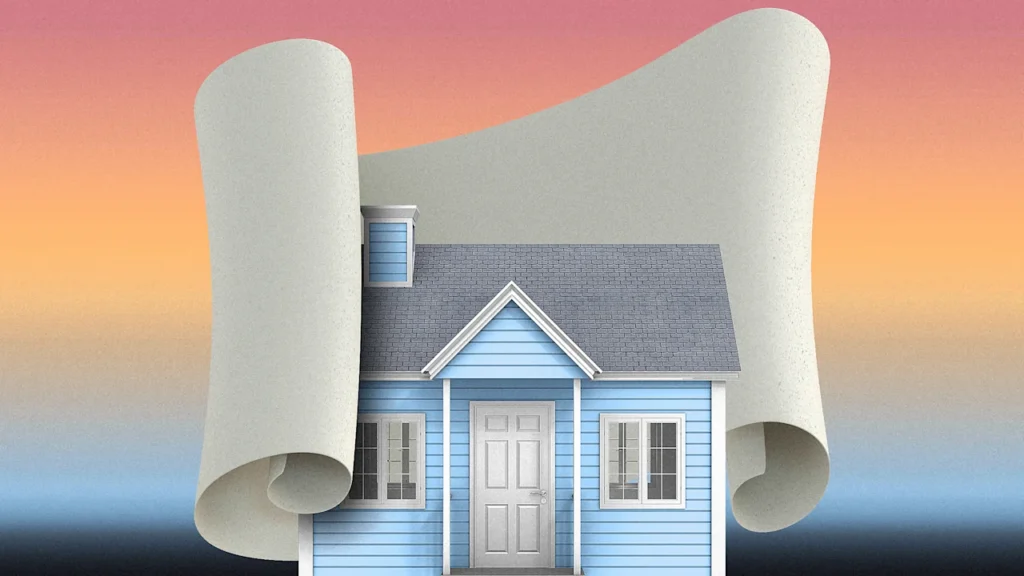
As weather disasters become more and more frequent, the home insurance system feels broken for Americans across the country. Now, the advocacy nonprofit Consumer Reports is trying to implement a “homeowners insurance bill of rights” to codify baseline protections across all 50 states.
According to a survey from the group, homeowners have seen their insurance rates climb—like Sierra in North Carolina, whose insurance spiked 43% last year, with her provider citing the “increased regional weather risks” as well as Hurricane Helene’s impact specifically.
They’ve been denied payouts, like Charmian in Illinois, who says their provider refused to pay for hail damage on their roof. Hail storms are becoming both more frequent and more damaging as global temperatures rise.
And some homeowners have been outright abandoned as insurance companies flee high-risk states and drop long-time customers. Because of the growing risk of wildfires, hurricanes, floods, and other disasters, homeowners have been dropped in states including California, Florida, and Louisiana, among others. Vicki in California is one example, even after she spent money on fire protection measures.
An industry ‘almost universally disliked’
Sierra, Charmian, and Vicki are some of the more than 500 Consumer Reports members who shared their insurance stories with the nonprofit when it began to look into the home insurance market.
Consumer Reports rates all sorts of products and services, from appliances to electric vehicles to anti-virus software. But it only just started covering insurance providers this year. The focus on home insurance was prompted by the January wildfires in Los Angeles—and the news that major providers like State Farm and other insurers had canceled hundreds of policies in the months before that disaster hit.
“It’s really been a flood of heartbreaking stories of people who have lost their homes that didn’t even know that they were in extreme weather risk regions and didn’t have sufficient insurance or even insurance at all to help rebuild,” says Sara Enright, Consumer Reports senior director of safety and sustainability advocacy.
Consumer Reports put out the call for stories from its members that January, and received responses filled with frustrations like reduced or eliminated coverage and skyrocketing rates from all 50 states.
In September, Consumer Reports revealed its ratings of best and worst homeowners insurance, the first time it did such a list. The nonprofit looked at 28 providers, but after surveying 24,000 policyholders, only three received a Consumer Reports recommendation.
“That’s pretty poor showing,” Enright says. “This is an industry that’s almost universally disliked by its customers.”
Nine rights for homeowners
The insurance industry is clearly struggling with the realities of climate change, and the extent to which extreme weather is becoming more common. The scale of damage is increasing to such an extent that traditional insurance models no longer apply to our current reality.
Consumer Reports wanted to help figure out some solutions. “We felt that there are things that the insurance industry could do to ease the pain on their customers in the meantime, as they figure out their business model under a world in which extreme weather events are going to occur more frequently,” Enright says.
So the nonprofit got to work writing up a Homeowners Insurance Bill of Rights, one that prioritized consumer voices. Along with more than 500 stories from members, it engaged more than 56,000 consumers in total to get feedback, which it then analyzed for certain themes. It also partnered with advocates that have studied insurance, like United Policy Holders and the Consumer Federation of America.
It came up with nine rights it says all policyholders should be guaranteed, and which would make the home insurance market more fair:
- A clear, plain-language explanation of what is—and isn’t—covered by your policy
- Knowing which risk factors are used to determine eligibility and set rates
- Fair access to coverage based on property risk, not your finances
- Receiving written notice and a full explanation well in advance of major changes to your insurance policy
- Benefitting from incentives to “harden” your home against severe weather or wildfire risk
- Insurance security during and after declared States of Emergency
- No penalties for inquiries and unpaid claims
- Prompt, full, and fair payment on a claim
- Immediate and adequate financial support for emergency housing and essentials
Some of these rights seem obvious, or like they’d already exist—like clear language around what a policy covers. But policies may not actually be that transparent to homeowners. It’s also an intentional way to call out how the industry can seem unfair, and unaccountable to its customers.
“A lot of the rights cover things where you’re like, ‘Why doesn’t that exist?’” Enright says. “Right after a disaster, don’t drop your home insurance policy right—that’s not legally required in most states, and that just seems like a very low hanging fruit for insurers to be able to say ‘no we’re not going to abandon you in your time of need.’”
A patchwork system
Though some of these rights aren’t legally required in certain states, the majority are already covered by at least one state law. The problem is that the insurance industry is a patchwork system, with different requirements and responsibilities from state to state.
“We believe that those rights should then be extended to all policyholders, to create a stronger protection network for everybody,” Enright says.
Consumer Reports wanted to ensure that these rights were possible, and that they could get onboard. Though it’s a fact that companies will drop customers in high-risk areas like California, the nonprofit didn’t feel it could call for a change to such business practices.
Canceling policies because the risk is too high, or hiking insurance rates are “business decisions that have to be made in the time of climate change,” Enright says. “Obviously we think that those should be overseen by state regulators, but it’s not something that we thought we could voluntarily ask insurance companies to say that they would stop doing.”
But the bill of rights does call for actions like providing enough advanced notice so homeowners can respond, fight back, or find a new provider before their insurance ends.
The full bill of rights also shares some tips for what homeowners can do to protect themselves in the meantime, before these rights are (hopefully) enacted—suggestions like asking if any risk scores were used to determine their premiums, and how they could improve their risk score to lower their rate.
There’s a customer education component to this crisis, Enright adds; many people don’t even know their basic home insurance package doesn’t cover flooding, for example.
Consumer Reports next steps
Still, Consumer Reports wants the insurance companies to adopt these rights, and state legislators to codify them. They were formed so as not to require dramatic business changes, Enright says, and Consumer Reports is also reaching out to all 28 insurers it rated this year to talk about how they can implement these changes.
“Our hope is that insurers will see some value in adopting, as an industry, universal rights that will level the playing field for all of them so that they are competing on customer service as much as anything else,” she says.
The nonprofit is also reaching out to industry groups and talking to state legislators about putting consumer protection policies in place. The insurance industry is legislated at the state level, so that’s where Consumer Reports is focusing. Consumer Reports also launched a petition asking for signatures in support of the Homeowners Insurance Bill of Rights.
At the federal level, like around FEMA or federal flood insurance, details are still up in the air as the Trump administration has cut departments and slashed services. Trump’s moves to gut the NOAA, the National Oceanic and Atmospheric Administration, may actually increase home insurance premiums and make companies drop even more homeowners, experts warned back in February, because the data that department once provided is crucial to understanding risk.
Though Consumer Report’s member stories reveal how frustrated homeowners are with their insurance companies, Enright wants to note that this effort isn’t about painting insurers as bad actors.
“This is a story about us adapting to extreme weather events driven by climate change,” she says. “We have to work together. We need the insurance industry to be strong so that communities can get through extreme weather events and be resilient. We need to find solutions that work both for insurance companies as well as consumers.”

